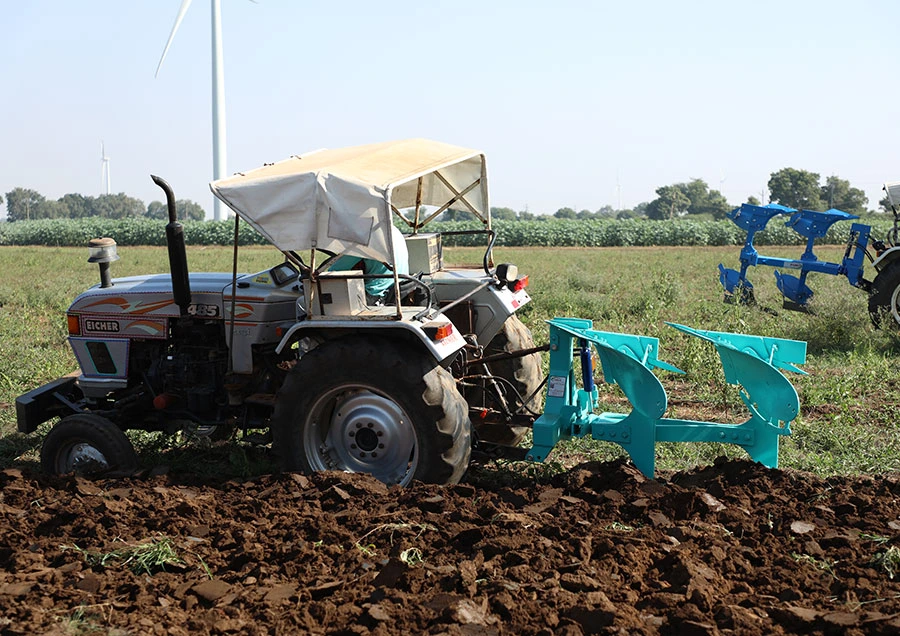Chat With Us
+91 99253 37969Tips To Maximize Fuel Efficiency With Reversible Disc Plough

A reversible disc plough is one of the most highly used and durable ploughing machines that provide excellent productivity in different field conditions. However, It is a tractor-operated machine and can consume a significant amount of fuel if the right measures are not taken.
Maximizing fuel efficiency while using your reversible disc plough not only saves you money but also ensures that your farming operations are more sustainable and environmentally friendly. Here are some practical tips to help you get the most out of your fuel while maintaining optimal performance.
Best Practices To Improve Fuel Efficiency With A Reversible Disc Plough
1. Regular Maintenance
Maintenance plays a pivotal role in maximising fuel efficiency and keeping the disc plough in good condition.
Check the Pressure of Tyres: Under-inflated tyres can put pressure on the engine and consume more power. Thus, check the pressure of tyres before ploughing to ensure optimal use of fuel.
Regular Lubrication: Friction between different parts of the disc plough can consume extra fuel and provide lesser productivity. Therefore, lubricate the moving parts regularly for smooth operations, which in turn helps in saving fuel.
Clean Air Filters: Air flow restrictions in the nozzles are one of the prominent reasons behind excessive fuel loss in reversible disc ploughs. Hence, scheduled maintenance of air filters is necessary for better fuel efficiency.
2. Optimal Ploughing Speed
Ploughing speed can significantly affect fuel usage. Maintaining the right speed becomes very important to create a balance between productivity and fuel efficiency. Let's have a look at how you can do it
Adjust Speed: Operating too fast can result in abrupt usage of fuel and less productivity. Similarly, low speed will increase ploughing time and fuel consumption. Thus, check the optimum speed in the manufacturer's manual before start operating the reversible disc plough.
Avoid Excessive Speed: High speed can moreover lead to engine damage and fuel leakage problems in the future. Therefore, try to avoid running the plough at maximum speed.
3. Proper Plough Adjustment
Plough adjustments are the techniques that provide you the freedom to adjust your plough's functionality according to different soil conditions. Using these adjustments optimally can improve fuel efficiency.
Correct Depth Settings: One of the crucial adjustments in this scenario is the depth adjustment. Digging too deep into the soil consumes excessive power and fuel. Therefore, adjust the plough to the correct depth to minimize resistance.
Align Discs: Adjust the distance between the disc and the hitch. Proper alignment provides higher productivity in individual attempts and can reduce the need for rework. Using these adjustments properly can help you save both a significant amount of time and fuel.
4. Efficient Field Patterns
Understanding your field and operating according to the right strategy reduces both effort and fuel. Using the reversible disc plough with right field patterns you can reduce unnecessary fuel consumption.
Plan Field Operations: Organize your field pattern to avoid unnecessary overlapping and rework during the ploughing procedure. For example, in compact fields, you can use the continuous ploughing technique for swift results. Similarly, for larger field areas round and round ploughing technique is more effective.
Turn Efficiently: Adjust the speed of the tractor during corners to take smooth turns and avoid fuel consumption.
5. Use Tractor Power Efficiently
Using the power of a tractor righteously is important to upscale fuel efficiency. Overpowering can lead to damage to both land and the plough. Therefore, you should follow the preventive measures while operating a tractor-operated disc plough.
Match Tractor Size: Use an appropriate size of tractor and hitch adjustment that is compatible with your reversible disc plough. Overpowered and underpowered tractors can lead to significant fuel loss.
Use Low RPM: Operating at a lower RPM while maintaining sufficient power can help reduce fuel consumption. Avoid running the engine at high RPMs unnecessarily.
6. Proper Weight Distribution
Inadequate weight distribution can lead to potential loss in fuel due to excessive power loss and improper traction. Therefore, balancing your reversible disc plough with the tractor becomes crucial.
Check The Hitch Adjustment: Most of the reversible disc ploughs work on a three-point hitch adjustment. However, it is always not necessary and depends on tractor size. Therefore, before operating the plough check the hitch adjustment properly to reduce balancing issues.
Avoid Excessive Weight: Ensure your tractor is properly ballasted to provide adequate traction without excessive weight. This balance helps in efficient fuel use by reducing slippage and improving overall performance.
7. Soil Awareness
Different soils have different requirements and knowledge about these adjustments can help in saving both time and fuel during ploughing. Thus, knowing the soil type becomes a key factor for fuel efficiency.
Avoid Wet Conditions: Ploughing in wet and marshy soil can lead to higher resistance and excessive power loss. It not only reduces efficiency but also consumes a potential amount of fuel. Thus, operating in dry conditions is a wise choice to save fuel.
Monitor Soil Type: Different soil types require different ploughing techniques and settings. Adjust your equipment and approach based on the soil you are working with to maximize efficiency.
Final Thoughts
Generally, fuel efficiency majorly depends on your understanding and experience in the field and usage of a disc plough. However, using the adjustments manual and guides you can save both fuel and time without compromising on productivity. Maintaining the good condition of the plough and tractor is also important to ensure the effective use of fuel.
Thus, connect with the manufacturer in case you need any kind of maintenance or repair requirements promptly. Last but not least, soil awareness plays a pivotal role in fuel-efficient ploughing, therefore, follow the right techniques on the right soil to gain maximum output with minimum loss of fuel.
Check Other Similar Blogs:





